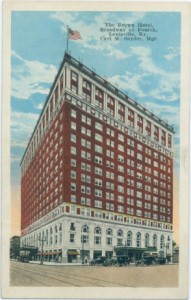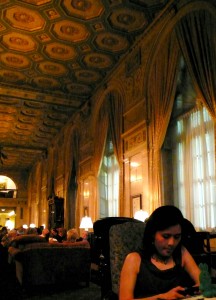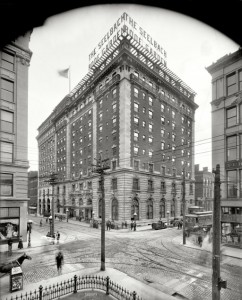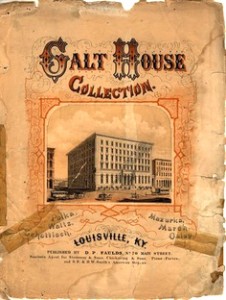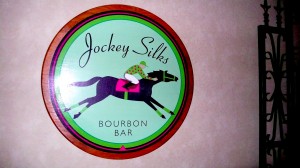An Urban Bourbon Trail Through History
When you step out the front door of one of downtown Louisville’s three historic hotels -- The Brown, The Seelbach, The Galt House -- you are within sight of the other two. We’re talking a few blocks from one to the next. But that didn’t stop my father from feeling the need to drive from one to the next as we indulged in our journey through the history of the city by way of three of its landmarks. Or more accurately, the bars and bourbon collections inside those three landmarks. Despite being the one-time capital of bourbon distilling (measured by the gallon, it probably still is, as both Brown-Forman and Heaven Hill do their distilling there), it took a little longer than it should for my home town to capitalize on bourbon tourism.
But once it cracked its neck and stepped into the ring like local boy Muhammad Ali, there was no stopping Louisville. Whiskey Row is being rehabilitated. New distilleries like Angels Envy, new bourbon tourism centers like Heaven Hill’s Evan Williams Experience, and hot shot meccas like the hotel 21c and its associated bar/restaurant Proof on Main have turned the city into a whiskey drinker’s must-visit destination, even if the burliest bourbon business centers -- Heaven Hill, Brown-Forman, and the (presumably) mist-shrouded Stitzel-Weller distilleries -- remain off-limits to the public.
While these new additions are welcome, for an old timer like me, someone who grew up prowling the streets of downtown when it was nothing but junkyards, stockyards, and a dingy punk rock club built on top of a secret S&M sex club, it’s the old guard of Louisville that has the most appeal. I got dressed up in the very finest tux that the Gingiss Formalwear in the mall had to rent, and went to prom at The Galt House. As ratty young skate punks, we'd sneak into The Brown, pretending we were jet-setting old money kings and queens.
Today, Louisville’s three most venerable hotels are part of the Urban Bourbon Trail, a boozy tour of the city’s premiere whiskey bars that really requires a designated driver since mass transit is still persona non grata. In these historic hotels, you can get a glimpse of the glamor, the opulence, and even the occasional sinister edge that epitomized Louisville during the Jazz Age. Granted, you might have to ignore the intrusion of flatscreen TVs and occasional disappointing booths, but it’s worth the effort.
The Brown
Starting at The Brown allows you not just to settle into an overstuffed chair and soak in the ambiance of the ornate old hotel’s lobby bar; it also gives you the chance to fortify yourself for a night’s drinking with the most famous thing to come from the bar: the Hot Brown. Opened in 1923 by local lumber and real estate magnate James Graham Brown, The Brown was meant to be direct competitor to the city’s grandest hotel, The Seelbach. In 1926, chef Fred Schmidt introduced the Hot Brown, an open faced sandwich of toast, turkey, bacon and Mornay sauce. It remains one of Louisville’s greatest contributions to society.
Floods and Prohibition hit The Brown hard, but through ups and downs it played host, usually during Derby Week, to some of the world’s most famous and glamorous, including Elizabeth Taylor, Harry Truman, and the Duke of Windsor. Sadly, the general malaise that settled into America’s urban centers during the 70s proved too much. The hotel went bankrupt, and the building was sold to the public school system to use as administrative offices with no regard for the art and architecture. It wasn’t until the 1980s, when the city began a dogged campaign of restoring and revitalizing itself, that The Brown was passed back into the hands of hoteliers, and restoration began. It took a massive amount of money to undo the cheap blandness inflicted during its years as a public services office, and work continued throughout the 90s and early 2000s. Today, much of the former glory has been returned to the hotel. Modernity rears its head from time to time -- the bar has an unwelcome (to me) TV marring the otherwise gorgeous setting -- The Brown is back to being a lavish maze of grand dining halls and ballrooms. The lobby bar is one of the best places to sit and lose yourself in time while you drink something warm and calming. A Willet perhaps, or Old Grand-Dad Bottled in Bond.
The Seelbach
Although visitors may not notice, Louisville’s old German immigrants played a huge role in defining the character of the city (we still have a neighborhood called Germantown, and you can get amazing German food at Gasthaus or kind of insane German-southern fusion at Eiderdown). And it was two immigrant brothers, Louis and Otto Seelbach, who in 1905 opened the city’s most exquisite hotel. Modeled after the ornate hotels of Vienna and Paris, The Seelbach fast became legendary, proclaimed one of the country’s best hotels. Frequent guests included F. Scott Fitzgerald, nine US Presidents, Elvis, and, during Prohibition, Al Capone and Lucky Luciano, who doubtless took advantage of the hotel’s secret tunnel to the riverfront that enabled imbibing patrons to make a quick getaway from pestering "prohis."
Much like The Brown, the economic depression of the 1970s dealt a death blow to the grand old hotel, and in 1975 The Seelbach was forced to close its doors. Luckily, it wasn’t the Board of Ed that took the building over. It sat largely dormant until Dark Shadows star and Louisville native Roger Davis began a restoration movement. The hotel reopened in 1982 and quickly reclaimed its spot as one of the best hotels in the country.
The lobby of the hotel is a sight to behold, and the bar, while not as warm and majestic as sitting in the lobby of The Brown, still retains some of its character -- but a little less than you might want. It’s well-stocked with bourbon, of course, but the ambiance can be lacking. The Seelbach’s position as one of the most popular hotels in the city means bourbon pilgrims and history nerds rub elbows with local businessmen and jogging suit clad tourists who have a tendency to bring their children everywhere. Still, when it comes to Louisville’s storied boozy past, there is no more essential stop than The Seelbach. And where The Brown has the Hot Brown, The Seelbach has the Seelbach cocktail (which I championed over the mint julep as the more appropriate Derby Day cocktail). A Seelbach or two at The Seelbach will help put you in a speakeasy state of mind regardless of who’s at the bar next to you.
The Galt House
I end at The Galt House because it’s closest to the river, and because it’s the tallest of Louisville’s historic hotels but also the ugliest, so having a few drinks in you beforehand is a good idea. The name conjures up images -- not by any fault of The Galt House -- of some Ayn Randian captain of industry clutching blueprints and staring at the city below him. Indeed, The Galt House sort of looks like that guy could be in the lofty 25th story penthouse. Looking up at the odd, anonymously modern facade, especially when measured against the exterior beauty of The Brown and The Seelbach, one wonders how such a place could be the oldest of Louisville’s three grand hotels.
Originally located at the corner of Second and Main, The Galt House was, well, the house of one Dr. W.C. Galt. It was transformed into a hotel in 1834 and seemed to attract a lot of Civil War luminaries. At one time or another, Union President Abraham Lincoln (born in Kentucky), Union general Ulysses S. Grant, and Confederate president Jefferson Davis (also born in Kentucky) all stayed at The Galt House. During the war itself, it was used as a military HQ for Union generals and was the site of a notorious murder, when Union general Jefferson C. Davis (not the same Jefferson Davis) argued with and shot fellow general William “Bull” Nelson. It’s also where Grant and Sherman met to plan Sherman’s (in)famous March to the Sea.
While Sherman was busy burning down Atlanta, The Galt House itself was busy burning down. It caught fire and was destroyed in 1865. A new Galt House was built, a block away, and opened in 1869. But it seems that without a steady stream of sideburned Civil War generals, the hotel fell on hard times. By 1919, just as The Seelbach was gearing up to become the city’s Prohibition hot spot and The Brown was taking shape, The Galt House went bankrupt. In 1921, the building was demolished.
Seemingly committed to being the opposite in every way, after having closed when the other hotels were opening, The Galt House reopened when The Brown and The Seelbach were closing. In 1972, The Galt House was revived, in yet another location and now taking advantage of advances in building technology while suffering from “advances” in design theory. The current Galt House -- two towers connected by a skyway -- is from the outside an anonymous looking place (well, as anonymous as you can be with a giant “Galt House” on
the side of the building). Inside, however, its mix of modern and traditional easily rivals the interiors of The Brown and The Seelbach.
It’s signature bar and stop on the Urban Bourbon trail is Jockey Silks. Like the bars at the other hotels, it is well-stocked with bourbon. It looks promising -- you are basically sitting in a glass cube with walls made of shelves lined with bourbon -- but the actual ambiance of Jockey Silks is a bit drab. Bright lights and booths that look like they belong in a fast food chain mar the magic a little, but you can still get a great drink from a friendly bartender at the end of the night. And if you want a more unique ambiance, you can always retire to Al J's Lounge at the Conservatory. There you are surrounded by plants and open glass ceilings, and oh yeah, the bar is an aquarium. The slightly rowdy, well-lit nature of Jockey Silks seems well suited for drinking something a little rowdier. Heaven Hill Gold Label Bottled in Bond will take care of you, and if you retire to Al J's Lounge at the Conservatory to drink with the fishes, there are worse ways to spend a drink than looking at the city with a glass of Jim Beam Black in your hands.

